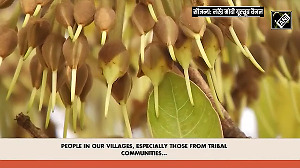In its landslide victory, the Bharatiya Janata Party has seen its vote share soar past 50 per cent in at least 13 states and Union territories, a feat which the rival Congress could manage only in Puducherry.

Besides, the main opposition party's voting percentage has remained in single digits in politically important states like Uttar Pradesh, West Bengal, Bihar and Andhra Pradesh, as per the latest data from the Election Commission.
As per the preliminary estimates, the BJP has significantly improved its national vote share from 31.34 per cent in 2014 to a new record high, while there appeared to be only a marginal change in case of the Congress from its 19.5 per cent score of the last elections.
The BJP had got 7.74 per cent vote share in 1984 when it got two Lok Sabha seats, after which it consistently saw an increase till 1998 (25.59 per cent) and then slipped for three consecutive national elections till 2009 (18.8 per cent), before surging again in 2014.
The Congress, which secured 45 per cent votes in the first parliamentary elections in 1952, saw its voting percentage remain in 40s till the 1971 elections. After a slump to 34.5 per cent in 1977, the Congress again returned to 42.7 per cent in 1980 and then to a record high of 48.1 per cent in 1984/85.
While the elections held immediately after Indira Gandhi's assassination in 1984 saw the Congress record a vote share of 49.1 per cent, it got 32.14 per cent votes in delayed polls that were held in Punjab and Assam in 1985 -- resulting in an overall figure of 48.1 per cent.
The Congress vote share, however, began to dip after that with its voting percentage dropping to 39.5 per cent in 1989 and further to 20s between 1996 and 2009, and even below that mark in 2014.
The state-wise preliminary data for the 2019 elections showed that the Congress could get a vote share of just about 6 per cent in Uttar Pradesh and West Bengal, and a little higher at about 7 per cent in Bihar. The score is even worse at just about 1 per cent in Andhra Pradesh and Sikkim.
Even in Punjab, where the party has done relatively well, the Congress vote share is about 40 per cent with Puducherry being the only place where it has crossed the half-way mark at about 57 per cent.
In comparison, the BJP has got close to 50 per cent in Uttar Pradesh and even higher in Haryana, Madhya Pradesh, Rajasthan, Chhattisgarh, Uttarakhand, Gujarat, Jharkhand, Himachal Pradesh, Goa, Karnataka, Delhi, Chandigarh and Arunachal Pradesh.
In West Bengal also, the BJP has secured close to 40 per cent votes and in Jammu & Kashmir it has scored approximately 46 per cent.
Among the states where it fought election in alliance, the BJP got close to 10 per cent in Punjab, 27 per cent in Maharashtra, 35 per cent in Assam, 24 per cent in Bihar and 3.34 per cent in Tamil Nadu.
In Telangana, the BJP has got nearly 20 per cent votes, while it could get only 0.9 per cent in Andhra Pradesh. In Kerala, the BJP has got nearly 13 per cent and over 38 per cent in Odisha.
Manash Kalita Neog, co-founder of policy advocacy firm Chase India, said the BJP's nearly 50 per cent vote share in UP is a testimony to the huge ground swell for Brand Modi.
"Pan-India, from a 31-32 per cent votes in 2014, as per the ongoing trends, we can say that the NDA will be hovering around 50 per cent vote share, which is a huge mandate considering the Hindi heartland as well south India has got strong regional parties," he said.
Anup Sharma, mentor and senior fellow at democratic sustainability think-tank The Lentils Institute, said Prime Minister Narendra Modi has cemented his brand identity that resonated with far more people voting for his party.
"Every election is fought on narratives and an agenda, and the opposition failed to create a narrative and only had one agenda -- Defeat Modi.
"Through a strategically planned outreach campaign and in-your-face messaging, the BJP's narrative overshadowed all other parties," he said.
While the Congress was unable to communicate what it stands for on major issues, the BJP on the other hand played around Modi's personal popularity and his strong image on national security and built the narrative around it, Sharma said.











 © 2025
© 2025